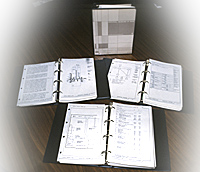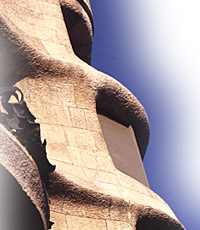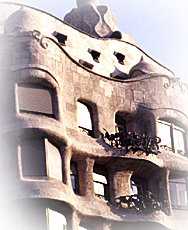FULL TOUR
The Design
Process - INFORMATION GATHERING
On the day set for the submission
of the architects' concept proposals, CMC staff, working with
the Architectural Services staff of the National Museums of
Canada corporation, completed the initial phase of deliberations
of the New Accommodation Task Force (NATF) with the issue of the
first edition of an architectural programme. This described:
- the museum's mandate, goals, history, functions, audiences,
and organizational structure;
- the New Accommodation project;
- site development guidelines, access needs, use and security
requirements, and landscaping concepts;
- general building requirements (e.g. image, functionality,
circulation, conservation, security);
- and a brief description of each of the principal areas
desired for the building, with functions, space requirements,
and adjacencies specified.
The architectural programme, second edition.
© Canadian Museum of Civilization, D2004-18590, CD2004-1377
|

|
Much of this document came out of the expertise of CMC staff,
harnessed through the NATF. The Task Force was divided into a
Public Programming Task Group and a Curatorial and Services Task
Group, under which there were 12 Study Teams planning for:
- education and interpretation;
- visitor amenities;
- gallery requirements;
- thematic concepts;
- security and fire protection;
- conservation;
- open storage;
- reserve collections;
- office and operational spaces;
- building maintenance and operations;
- documentation centre;
- and new technology.
To obtain ideas from a broader audience, the NATF surveyed the
attitudes and wishes of the museum community regarding the new
museum. Some 1400 discussion guides/questionnaires were sent out
(July 1982) to the museum's staff, Advisory Committee, Board of
Trustees, Canadian Museums Association membership, and other
interested individuals. By October 1983 the architectural
programme had swollen into a second edition of four large
volumes of over 1200 pages. They included more detailed
descriptions of individual spaces in the new building, lengthier
specifications relating to conservation, security, and
communication systems requirements, and a visitor projection
model.
The design and production of a building as complex and demanding
as a major museum could hardly be a simple sequence of
architectural programme, architectural design, and construction,
however. It was very much an interactive process. As important
to Cardinal as the written documents was the continuing dialogue
between architect's and museum staffs. The latter provided
initial input (the architectural programme). The former
responded with a design, in the form of a model and
architectural blueprints, interpreting the programme. CMC staff
came back with an analysis and criticism of the interpretation.
The drawings were revised and submitted to a fresh round of
feedback. And so on.

Douglas Cardinal (at left) demonstrates his
site plan printer to Jean Boggs, CEO of the Canada Museums
Construction Corporation, Francis Fox, Minister of
Communications, Léo Dorais, Secretary-General of the
National Museums of Canada, and George MacDonald, Director of CMC.
© Douglas J. Cardinal Architect Ltd.
|
It was a learning process for both parties. It encouraged
increasingly specific and careful conceptualization and
verbalization of needs, as museum staff and architects learned
each others' languages and thought patterns. Furthermore the
conversational process was integral to the "from the inside
out" design philosophy of Cardinal: allowing those persons
who had lived and breathed museums for years to express
themselves fully and provide an informational framework for the
architect's creativity. Through this process the original
visions - both of the architect and of CMC staff -
evolved. And it is the nature of evolution to produce an entity
which is more appropriate to its environment than its
forebears.
The above is still a simplistic description of the process of
design. Its real complexity may be suggested by the number of
parties who had a role in it:
- Central to the process were the architect and his staff and
CMC's staff. Although in a project this complex there were some
disagreements along the road, as each group struggled to
understand the other's viewpoint, the relationship was on the
whole harmonious.
- Other components of the National Museums corporation -
notably Architectural Services, Security Services, and the
Canadian Conservation Institute - contributed to the
architectural programme.
- The RCMP was consulted on security, and the Dominion Fire
Commissioner, as well as provincial and city experts, helped
with standards relating to safety concerns.
- Public Works Canada gave technical information on
maintenance standards and space requirements, while the
National Capital Commission specified design criteria that
would ensure the building complied with federal objectives for
the development of the Capital Core Area.
- Numerous consultants helped with engineering standards,
laboratory layouts, building lighting, vertical transportation,
landscaping, acoustics, and many other matters, while industry
was approached about preliminary requirements for products such
as high-density mobile shelving, dock levellers, etc.
- And, finally, the Canada Museums Construction Corporation
was kept busy coordinating all these groups with the project as
a whole.
CMC staff also looked further afield for information, visiting
(or consulting by phone or letter) museums and other cultural,
recreational, and educational institutions, both in Canada and
abroad. CMC is not modelled on any single institution, but it
was desired to identify the most appropriate features for CMC
and absorb them into the evolving design. Among those which had
early influence:
- the regional orientation of the Museum of Anthropology in
Mexico City, and its role in portraying Native culture to a
modern society;
- the achievement of Native involvement in the programmes of
the Museum of Anthropology at the University of British Columbia;
- successful children's museums at Boston and Indianapolis;
- outstanding exhibit techniques at the British Columbia
Provincial Museum, and particular exhibitry in the Smithsonian's
Museum of American History;
- the changing exhibits programme of the British Museum;
- the use of environmental reconstructions at the last-named,
in York Castle Museum, Milwaukee Public Museum, and in outdoor
museums generally;
- interactive exhibits in science centres, notably San
Francisco's Exploratorium;
- intriguing uses of space in museums at Santa Barbara, Nagoya
and Otami (Japan), and general application of new technology in
some major Japanese museums;
- innovative techniques and technologies at cultural centres
such as France's Centre Pompidou and Parc La Villette, Expo 85
and Expo 86, and at Epcot Center.
From such influences CMC planners sought to synthesize a new
model, unique to the Canadian experience and responsive to a
wide range of audiences.
 
Cardinal's own influences include the
visionary work of Modernist architect Antoni Gaudi, whose early
20th century works in Barcelona Cardinal had an opportunity to
see first-hand thanks to the New Accommodation Project. The
curving terraces of CMC's curatorial wing recall the forms of
Gaudi's Casa Mila.
© George F. MacDonald
|


|